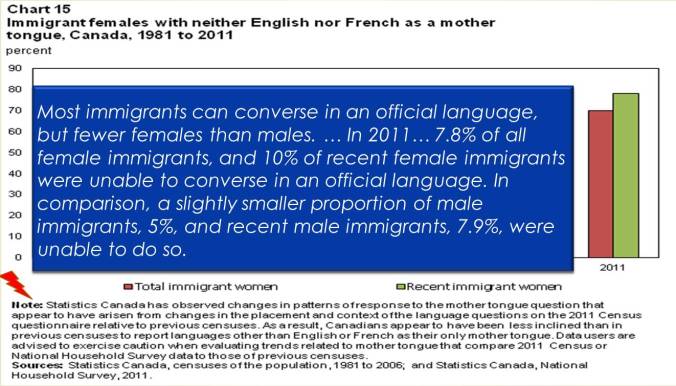Language emerges as a key factor when one considers what influences a newcomer woman’s chances of social inclusion and safety from violence. Language shapes how immigration is experienced and has a profound impact on the quality of immigrant women’s lives.
On the one side, command of one of the two Canadian official languages, English and French can decrease isolation, improve employment opportunities, promote communication with society, and improve access to services. On the other side, the inability to communicate in English or French can turn the smallest social activity into a tortuous endurance challenge.
To paraphrase Alma Estable’s 1986 report (Immigrant women in Canada, current issues: a background paper prepared for the Canadian Advisory Council on the Status of Women): not speaking one of the two official languages reduces access to information and services – human and civil rights, fair employment practices, social welfare, Canadian law. It aggravates the challenges of unemployment, underemployment and ghettoization (cultural and job-related).Lack of language makes women easy victims for exploitation, violence and abuse inside and outside the home. Women without English and French experience isolation in their daily lives. Things that we take for granted – a shopping trip, buying groceries, trying to speak with neighbours or with a child’s teachers – become exhausting ordeals.
Attending ESL classes might seem like a good solution – but is it? Who will arrange for childcare? What about transportation and time off from chores or work shifts? Are teachers multi- or even bilingual? How sensitive, diverse and empowering are the teaching materials available? Finally, are the types of instruction provided even partially adequate to the (highly variable) needs of the women in the classes?
Regarding ghettoization at the workplace – what that means is that in the absence of English and French language skills (and often enough, despite command of these languages) women are forced to seek work in places where official language skills are not essential to the job – laundries, cleaning companies etc. In those settings, language skill acquisition is uncertain, as women may mostly interact with peers from their own communities, which is often related to the fact that many find such low-skilled employment via their primary social contacts in their own ethnic communities. These interactions may reduce isolation and promote mutual support in some ways, but in other ways, they also increase isolation from those outside the immediate interactional networks, especially those from other linguistic backgrounds.
Estable suggests that not being able to operate in the language of the society alters the balance of power in a woman’s personal sphere. Many immigrant women find themselves entirely dependent on their husband or children for communication outside the home. Isolation meets dependency. As well, even women who used to work outside the home in their own countries are suddenly forced into isolation and dependence after immigration.
The lack of connections and language skills has adverse implications for immigrant women’s labour force participation, apart from lowering their access to social capital, general life satisfaction, and increasing their vulnerability to violence and ill-health while keeping them from accessing available supports.

From Hudon, T (2015) Report: Immigrant Women
http://bit.ly/1N4GT1B